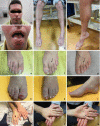A novel frameshift deletion in autosomal recessive SBF1-related syndromic neuropathy with necklace fibres
- PMID: 32444983
- PMCID: PMC7419361
- DOI: 10.1007/s00415-020-09827-y
A novel frameshift deletion in autosomal recessive SBF1-related syndromic neuropathy with necklace fibres
Abstract
Objective: To identify the genetic cause of complex neuropathy in two siblings from a consanguineous family.
Methods: The patients were recruited from our clinic. Muscle biopsy and whole-exome sequencing (WES) were performed. Fibroblasts cell lines from the index patient, unaffected parents, and three normal controls were used for cDNA analysis and western blot.
Results: The index patient was a 29-year-old male with clinical phenotype of syndactyly, pes cavus, swallowing difficulties, vision problem, imbalance, and muscle weakness. The sibling had similar, but milder symptoms. Nerve conduction studies and electromyography of both patients suggested sensory-motor axonal neuropathy. Muscle biopsy showed a feature of necklace fibres. WES identified a novel homozygous frameshift deletion (c.5477-5478del; p.1826-1826del) in exon 40 of the SBF1 gene in the two siblings, while both parents and the unaffected sibling were heterozygous carriers. Functional analysis showed a markedly reduced level of MTMR5 protein encoded by SBF1 in the index case. The levels of MTMR5 protein in unaffected parents were similar to those found in controls.
Conclusion: A novel homozygous frameshift deletion in SBF1 was identified in this family. Sensory-motor axonal neuropathy and necklace fibres in biopsy were the major features expanding the phenotypic spectrum of SBF1-related recessive syndromic neuropathy.
Keywords: CMT4B; MTMR5; Necklace fibres; SBF1.
Conflict of interest statement
The authors declare that they have no conflict of interest.
Figures




Similar articles
-
SBF1 mutations associated with autosomal recessive axonal neuropathy with cranial nerve involvement.Neurogenetics. 2017 Jan;18(1):63-67. doi: 10.1007/s10048-016-0505-1. Epub 2016 Dec 22. Neurogenetics. 2017. PMID: 28005197
-
Novel SBF1 splice-site null mutation broadens the clinical spectrum of Charcot-Marie-Tooth type 4B3 disease.Clin Genet. 2018 Nov;94(5):473-479. doi: 10.1111/cge.13419. Epub 2018 Aug 9. Clin Genet. 2018. PMID: 30039846
-
Bi-allelic variants in MTMR5/SBF1 cause Charcot-Marie-Tooth type 4B3 featuring mitochondrial dysfunction.BMC Med Genomics. 2021 Jun 12;14(1):157. doi: 10.1186/s12920-021-01001-1. BMC Med Genomics. 2021. PMID: 34118926 Free PMC article.
-
Autosomal recessive MFN2-related Charcot-Marie-Tooth disease with diaphragmatic weakness: Case report and literature review.Am J Med Genet A. 2016 Jun;170(6):1580-4. doi: 10.1002/ajmg.a.37611. Epub 2016 Mar 8. Am J Med Genet A. 2016. PMID: 26955893 Review.
-
[A pedigree of Charcot-Marie-Tooth disease type 4F (Periaxin mutation)].Rinsho Shinkeigaku. 2005 Mar;45(3):221-5. Rinsho Shinkeigaku. 2005. PMID: 15835292 Review. Japanese.
Cited by
-
Establishment and characterization of three human pluripotent stem cell lines from Charcot-Marie-Tooth disease Type 4B3 patients bearing mutations in MTMR5/Sbf1 gene.Stem Cell Res. 2024 Dec;81:103599. doi: 10.1016/j.scr.2024.103599. Epub 2024 Oct 22. Stem Cell Res. 2024. PMID: 39461113 Free PMC article.
-
Potential Candidate Genes for Therapeutic Targeting in Chronic Myeloid Leukemia: A Pilot Study.Asian Pac J Cancer Prev. 2023 Sep 1;24(9):3077-3085. doi: 10.31557/APJCP.2023.24.9.3077. Asian Pac J Cancer Prev. 2023. PMID: 37774059 Free PMC article.
-
A novel SBF1 missense mutation causes autosomal dominant Charcot-Marie-Tooth disease type 4B3.Front Neurol. 2024 Nov 22;15:1495711. doi: 10.3389/fneur.2024.1495711. eCollection 2024. Front Neurol. 2024. PMID: 39664754 Free PMC article.
-
Characterization of a novel zebrafish model of MTMR5-associated Charcot-Marie-Tooth disease type 4B3.Brain Commun. 2025 Feb 18;7(2):fcaf077. doi: 10.1093/braincomms/fcaf077. eCollection 2025. Brain Commun. 2025. PMID: 40066109 Free PMC article.
-
Genetic Mapping of Behavioral Traits Using the Collaborative Cross Resource.Int J Mol Sci. 2022 Dec 30;24(1):682. doi: 10.3390/ijms24010682. Int J Mol Sci. 2022. PMID: 36614124 Free PMC article.
References
Publication types
MeSH terms
Substances
Grants and funding
LinkOut - more resources
Full Text Sources
Medical
Molecular Biology Databases

